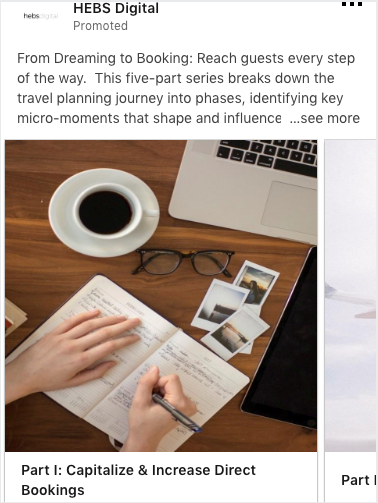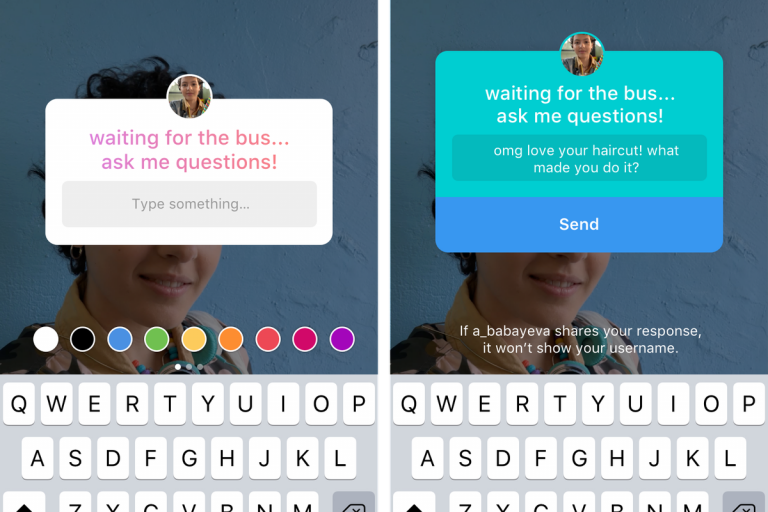
By Margaret Mastrogiacomo, VP Strategy
This month, the latest digital innovations include big announcements from Google regarding new merchandising features on Google AMP Stories, new LinkedIn advertising opportunities, and Instagram’s new questions sticker functionality for Stories. From SEO to design, find out the top five things you need to know now in hotel digital marketing.
1. SEO: Google releases AMP Stories 1.0 with advertising opportunities. If you haven’t already heard, AMP stories are standalone compilations of pages with AMP and HTML layers of elements such as video, photography, analytics, text and more. Similar to Snapchat and Instagram Stories, AMP stories provide publishers with rich media storytelling options designed for the mobile web. Now, Google is launching a new beta available to publishers using DoubleClick for Publishers (soon to be called Google Ad Manager) to serve ads within AMP stories with a “Shop Now” button.
As this beta rolls out, this is a great opportunity for hotels to increase organic visibility of their room types in mobile searches. Hotels can highlight videos and images of accommodations with the ability for users to book the room right from the Google AMP story.
2. SEM: Google reveals “People also searched for” in paid search results. Google has been providing suggested queries for organic search results for quite some time. Now, many marketers have discovered that the search giant has started to include the “People also searched for” search suggestions just beneath paid search ads in Google search results. The idea is that including suggested queries among organic and paid results saves the user from having to scroll to the bottom of the page to find their desired search result, and it allows users to quickly perform a refined search if they’re not finding what they want among the current results.
The upside for hotel marketers is that if a user makes a search query that doesn’t result in exactly what they are looking for, Google prominently suggests a more relevant search term for what they desire before the user costs you a click and abandons the page because it’s not what they were looking for.
The downside is that this could also mean they end up searching on a competitive brand name after leaving your site as many search marketers have noticed that sometimes competitive brand names are in the highlighted suggested searches.
3. Display: LinkedIn introduces new Carousel Ads. This month, LinkedIn announced Carousel Ads for Sponsored Content, a new way to tell your brand story and interact with your target audience on LinkedIn. This offering allows you to bring your brand story to life by featuring multiple visuals that users can horizontally swipe through while on the LinkedIn feed.
A great B2B marketing tool, LinkedIn Carousel Ads are the perfect way to market your hotel product to travel agents. Simply set the targeting to the desired occupations (travel agents, etc), highlight rich imagery of your room types, lobby, and inspiring spaces throughout the carousel functionality, and craft an enticing call-to-action. In a beta test, B2B marketers reported increased engagement and click-through rates using this new ad format.
4. Social: Instagram introduces a new questions sticker functionality for Instagram Stories. This month, Instagram launched a new interactive questions sticker that allows followers to submit questions for your hotel brand to answer. Hotel Instagram managers can add a question sticker to their story by selecting it from the sticker tray after taking a photo or video to be posted to the story. Next, simply type out the prompt then place it wherever desired within the story. When followers see the sticker, they can tap it to reply — and they can reply as many times as they want, right from the sticker.
This is a great new feature for hotel brands to act as a concierge to Instagram followers allowing potential guests to submit questions about the hotel, things to do in the destination, or any other concierge type topics.
5. Design: Exaggerated shadows are taking the forefront.
While flat design still plays a role in clean and modern design trends (perfect for fully-responsive design across devices), with the rise of augmented reality and better graphic displays, the drop shadow is back, but this time with a different look in mind. Providing extra depth and a 3D look to specific elements on your hotel website makes them stand out, as if you could reach out and touch them.
Elements on the hotel website you may want to give a 3D view could be delectable dishes from your onsite restaurant, and other standout elements of your destination such as towering palm trees.





